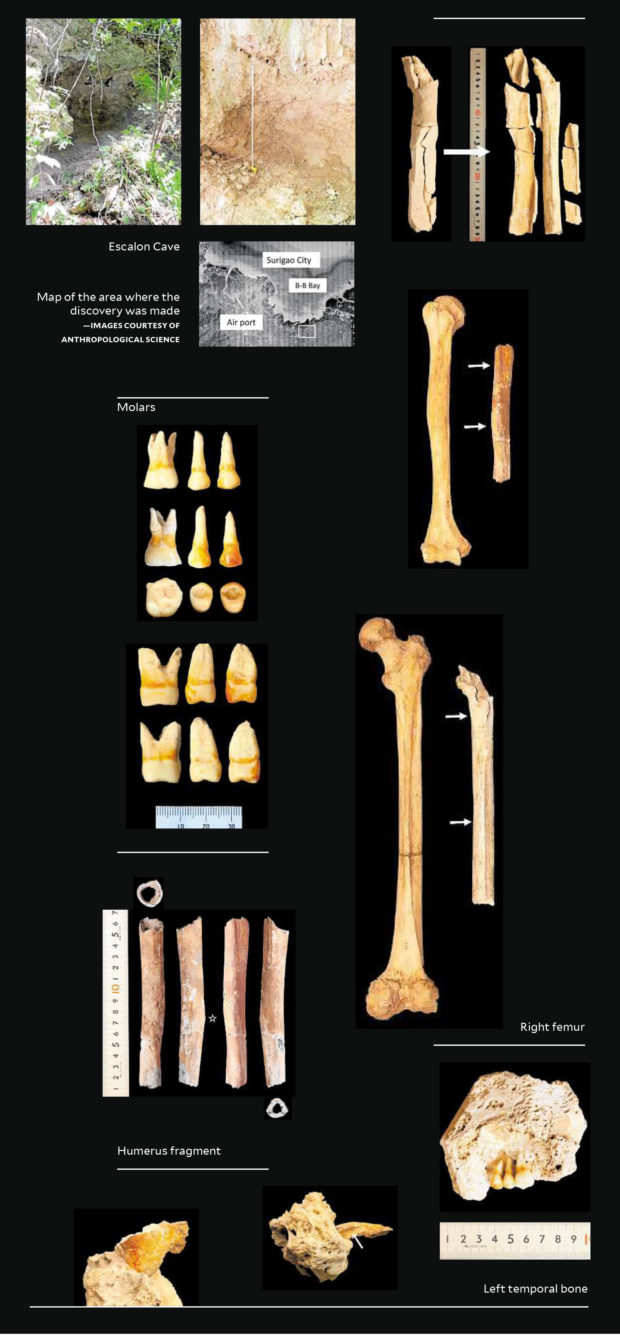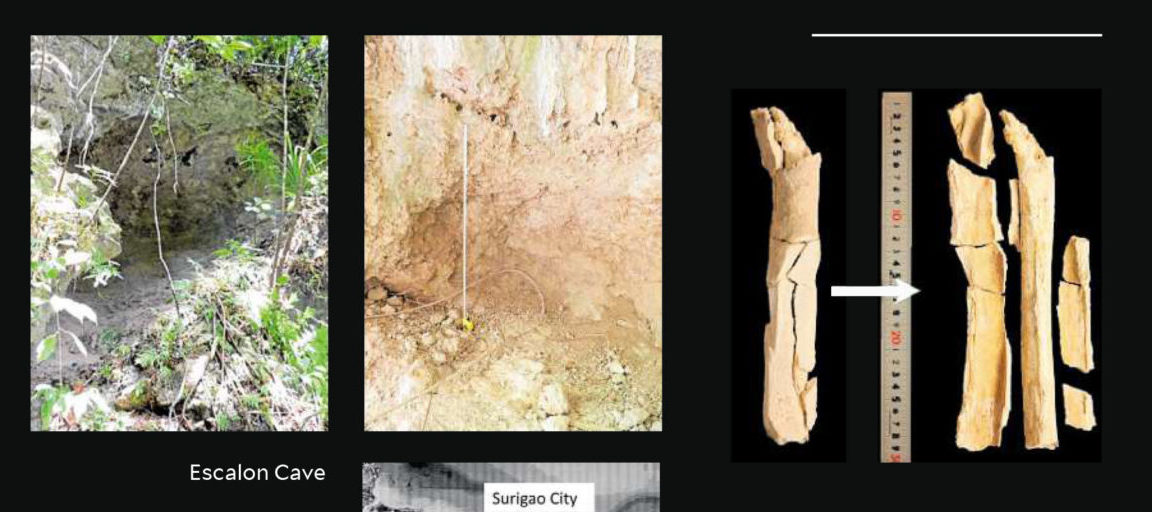Scientists from Japan and the Philippines have recently discovered a type of modern human that lived in Southern Philippines from the late Neolithic to the early Iron Age and named it the Escalon Man.
The Homo sapiens type Escalon Man was identified from bones discovered from the Escalon Cave in Surigao City, Surigao del Norte province, in the 1980s by a treasure hunter, which was embedded in the flowstone floor deposits.
This discovery was recently published in Anthropological Science, the official journal of the Anthropological Society of Nippon in Japan by authors from the University of Tokyo, Japan’s National Museum of Nature and Science, Kitahara Gakuin College of Dental Hygiene, University of Yamanashi, the College of Social Sciences and Philosophy of the University of the Philippines (UP) Diliman and the Surigaonon Heritage Center in Surigao City.
The dating of the “early-middle adult” and Austronesian-speaking Escalon Man is pegged at 2692 plus/minus 39 years BP (before present), or about 4,700 years ago.
The remains examined included a left temporal bone, the right humerus, the right femur, the upper right first and second premolars, and the first molar.
Initial scholarly investigation on the Escalon Cave and the human remains later to be identified as the Escalon Man was undertaken by the Surigaonon Heritage Center in 2003, which found the cave previously mined with calcite and flowstones.
However, “the precipitation and deposition of calcite within the cave” proved the information provided by the treasure hunter in the 1980s that there was a presence of human bones inside the cave that are particularly embedded in the flowstone floor deposits.
A coordination between local and Japanese scholars led to the transportation of the remains to the National Museum of the Philippines and Tokyo’s National Museum of Nature and Science in 2008 and 2009 respectively where the remains were examined and studied.
Important discovery
“The Neolithic Austronesian Escalon Man of Surigao City has turned out to be the most important archaeological Neolithic discovery in the Philippines since the unearthing by Dr. Robert B. Fox in 1962-1966 of the Neolithic Mongol-like Duyong Man in Duyong Cave, Quezon, Palawan,” said Leslie Bauzon of UP Diliman and one of the authors of the journal article.
“The Escalon Man significantly provides human skeletal evidence of the Austronesians whose amazing navigation feat based on indigenous knowledge of astronomy using wooden outriggered boats in coming and going led to the peopling of the Philippines, Island Southeast Asia, all the way to Polynesia,” he added.
This discovery is the recent of the important discoveries on the peopling of the Philippines in recent years which included the identification of Homo luzonensis and the 709,000-year-old butchered fossil of a rhinoceros in Kalinga, the earliest evidence of human presence in the country.
In addition to it as a significant discovery, Bauzon said, “Surigao del Norte is in my view the most exciting place in the Philippines right now for the study of early human life and formation of Filipino culture.”
Agriculturist
Results from radiocarbon and mitochondrial DNA analyses, according to the researchers, “indicated that the Escalon Man belongs to the haplogroup E1a1a, which is known to be the marker of Austronesian-speaking agriculturist populations that originated in Taiwan and spread southward through the Philippines to the Western Pacific, since about 4000 BP.”
They said this type is less diverse in the Philippines and in the Sulawesi Islands, which suggests its movement during the postglacial period.
The study also indicated that the Escalon Man is taller than the Aeta, Mamanwa and Negrito people who arrived in the country during the late Paleolithic area, which is about 50,000 to 10,000 years ago.
It also noted that the Escalon Man is a farmer and not a hunter-gatherer and theorized it to be the ancestors of Mindanao groups, notably the Manobo.
This discovery, according to the researchers, opens more questions on the movement of people to the Philippines and is an important archaeological literature for the country.
“This study has made notable contributions to the archaeological literature of the Philippines due to its integration of physical and biological anthropology, including the use of radiocarbon dating and DNA testing,” the researchers said.
“Such unique elements enabled us to make reasonably accurate inferences about the genetic origins and life of the Escalon Man,” they added.
Austronesian
The Austronesians are a group of modern people (Homo sapiens) inhabiting portions of the insular Southeast Asia including Malaysia, the islands of Taiwan, the Philippines, Indonesia and the present-day countries of East Timor, Papua New Guinea, New Zealand as well as the Pacific Islands.
It is believed that this group originated from Taiwan through seaborne migration.
The Austronesian group of people’s westernmost terminus is the island of Madagascar east of the African continent, while its easternmost terminus is Easter Island, or Rapa Nui, in the Pacific, which is now part of Chile.
It is among the largest language group in the world, which translates to a fifth of the world’s languages.
In the Philippines, the more than 160 languages spoken by its inhabitants are Austronesian although the Aeta, Agta, Ata and similar groups originally spoke a language or languages not related to the former.
A milestone
Going back to the Escalon Man, it is a significant milestone in the study of prehistoric skeletal remains of Homo sapiens, or modern humans, in the country as there are only few.
These include studies of skeletal remains at the Tabon and Duyong caves in Palawan, at the shell midden site in Lal-lo town, Cagayan province, and in Panhutongan archaeological site in Placer town, Surigao del Norte province.
The specimens in the aforementioned sites date from about 24,000 BP to 140 AD.
The study and subsequent identification of the Escalon Man is particularly important in the island of Mindanao as it gives a glance on how the island was settled in prehistoric times.
Plus, Mindanao will now have an official representative in the identified human remains in the country such as the Callao Man (Homo luzonensis), discovered inside the Callao Cave in Peñablanca town, Cagayan province, and Tabon Man (Homo sapiens) from the Tabon Cave at the Tabon Cave Complex in Quezon, Palawan’s Lipuun Point.
And as an interesting bit of information, Escalon Man’s fellow Austronesians, said Bauzon, “who found their way to Polynesia may have been responsible in introducing the Southeast Asian red jungle fowl (Gallus gallus, with a Philippine subspecies Gallus gallus domesticus)—ancestor of all chickens in the world—to the Americas!” —CONTRIBUTED INQ














































